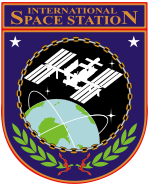Ibùdó Òfurufú Akáríayé: Ìyàtọ̀ láàrin àwọn àtúnyẹ̀wò
Content deleted Content added
k Bot Títúnṣe: stq:Internationoale Ruumstation; cosmetic changes |
k Bot Fífikún: la:Statio spatialis internationalis |
||
| Ìlà 82: | Ìlà 82: | ||
[[ka:საერთაშორისო კოსმოსური სადგური]] |
[[ka:საერთაშორისო კოსმოსური სადგური]] |
||
[[ko:국제 우주 정거장]] |
[[ko:국제 우주 정거장]] |
||
[[la:Statio spatialis internationalis]] |
|||
[[lb:International Raumstatioun ISS]] |
[[lb:International Raumstatioun ISS]] |
||
[[lt:Tarptautinė Kosminė Stotis]] |
[[lt:Tarptautinė Kosminė Stotis]] |
||
Àtúnyẹ̀wò ní 20:48, 11 Oṣù Kẹta 2010
 | ||
| The International Space Station on 8 September 2009 as seen from the departing Ọkọ̀-àlọbọ̀ Òfurufú Discovery during STS-128. | ||
 | ||
| ISS Insignia | ||
| Station statistics | ||
|---|---|---|
| NSSDC ID: | 1998-067A | |
| Call sign: | Alpha | |
| Crew: | 6 | |
| Launch: | 1998–2011 | |
| Launch pad: | KSC LC-39, Baikonur LC-1/5 & LC-81/23 | |
| Mass: | 303,663 kg (669,461 lb) (15 October 2009)Àdàkọ:Update after | |
| Length: | 73 m (240 ft) from Harmony to Zvezda | |
| Width: | 108.5 m (356 ft) along truss, arrays extended | |
| Height: | ~20 m (~66 ft) nadir-zenith, arrays forward-aft | |
| Living volume: | 358 m³ (12,626 ft³) (15 October 2009)Àdàkọ:Update after | |
| Atmospheric pressure: | 101.3 kPa (29.91 inHg) | |
| Perigee: | 341 km altitude (184 nmi) (15 September 2009) | |
| Apogee: | 353 km altitude (191 nmi) (15 September 2009) | |
| Orbit inclination: | 51.6419 degrees | |
| Average speed: | 27,743.8 km/h (17,239.2 mph, 7,706.6 m/s) | |
| Orbital period: | c.91 minutes | |
| Days in orbit: | 9282 | |
| Days occupied: | 8571 | |
| Number of orbits: | c.146490 | |
| Orbital decay: | 2 km/month | |
| Statistics as of Àdàkọ:Date (unless noted otherwise) | ||
| References: [1][2][3][4][5] | ||
| Configuration | ||
 | ||
| Station elements títí di Oṣù Kọkànlá 2009[update] (exploded view) | ||

|
Àyọkà yìí tàbí apá rẹ̀ únfẹ́ àtúnṣe sí. Ẹ le fẹ̀ jù báyìí lọ tàbí kí ẹ ṣàtúnṣe rẹ̀ lọ́nà tí yíò mu kúnrẹ́rẹ́. Ẹ ran Wikipedia lọ́wọ́ láti fẹ̀ẹ́ jù báyìí lọ. |
Itokasi
- ↑ Àṣìṣe ìtọ́kasí: Invalid
<ref>tag; no text was provided for refs namedISStD - ↑ Àṣìṣe ìtọ́kasí: Invalid
<ref>tag; no text was provided for refs namediss-height - ↑ Àṣìṣe ìtọ́kasí: Invalid
<ref>tag; no text was provided for refs namedOnOrbit - ↑ Chris Peat (September 15, 2009). "ISS—Orbit Data". Heavens-Above.com. Retrieved September 16, 2009.
- ↑ Steven Siceloff (February 1, 2001). "NASA Yields to Use of Alpha Name for Station". Florida Today. Retrieved January 18, 2009.
